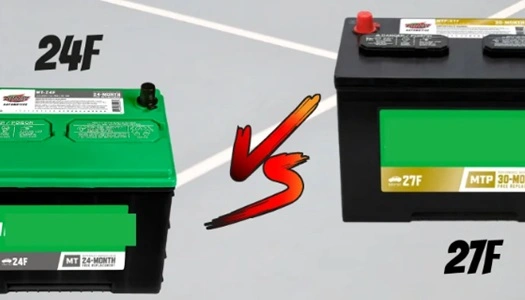When it comes to automotive batteries, selecting the right size is crucial for optimal performance, safety, and longevity of your vehicle. Among the many battery group sizes available, the 24F and 27F batteries are commonly used in various types of vehicles, especially in sedans, SUVs, and trucks. While these batteries may appear similar in function, they differ in dimensions, capacity, weight, and intended applications.
This article explores the difference between 24F and 27F batteries, covering their specifications, features, and how to choose the right one for your vehicle.
What Are Group Sizes in Batteries?

Battery group sizes, such as 24F and 27F, are standardized by the Battery Council International (BCI). These group sizes define specific dimensions, terminal orientations, and compatibility with different vehicle models. The group size ensures that the battery fits securely in the vehicle’s battery compartment and provides the required power.
What Is a 24F Battery?
A 24F battery is a mid-sized automotive battery commonly used in many sedans, compact SUVs, and some light-duty trucks. It is designed to deliver reliable starting power and sufficient reserve capacity for vehicles with moderate power demands.
Specifications of 24F Battery
- Dimensions: Approximately 10.9 inches (length) x 6.8 inches (width) x 8.9 inches (height).
- Cold Cranking Amps (CCA): Typically ranges from 550 to 750 CCA, depending on the brand and model.
- Reserve Capacity (RC): Around 120 to 140 minutes.
- Weight: Approximately 40 to 45 pounds.
- Terminal Position: The positive terminal is usually on the right side.
Common Applications
- Mid-sized sedans (e.g., Toyota Camry, Honda Accord).
- Compact SUVs.
- Vehicles with moderate electrical systems and accessories.
What Is a 27F Battery?
A 27F battery is a larger automotive battery designed for vehicles with higher power demands. It offers more capacity, making it suitable for larger SUVs, trucks, and vehicles with multiple accessories.
Specifications of 27F Battery
- Dimensions: Approximately 12.1 inches (length) x 6.8 inches (width) x 8.9 inches (height).
- Cold Cranking Amps (CCA): Typically ranges from 600 to 850 CCA, depending on the brand and model.
- Reserve Capacity (RC): Around 150 to 180 minutes.
- Weight: Approximately 50 to 60 pounds.
- Terminal Position: The positive terminal is usually on the right side.
Common Applications
- Full-sized SUVs and trucks.
- Vehicles with advanced electrical systems and accessories (e.g., off-road lights, winches).
- Marine and RV applications.
Key Differences Between 24F and 27F Batteries
| Feature | 24F Battery | 27F Battery |
|---|---|---|
| Dimensions | Smaller: 10.9″ x 6.8″ x 8.9″. | Larger: 12.1″ x 6.8″ x 8.9″. |
| Cold Cranking Amps | Lower CCA (550–750). | Higher CCA (600–850). |
| Reserve Capacity | Moderate (120–140 minutes). | Higher (150–180 minutes). |
| Weight | Lighter (40–45 pounds). | Heavier (50–60 pounds). |
| Applications | Suitable for sedans and compact SUVs. | Ideal for larger SUVs, trucks, and heavy-duty vehicles. |
| Power Demand | Designed for moderate power requirements. | Built for higher power demands and advanced systems. |
| Price | Typically more affordable. | Generally more expensive due to higher capacity. |
1. Dimensions and Fit
The 24F battery is slightly smaller than the 27F battery, making it ideal for vehicles with limited battery compartment space. The 27F battery’s larger size provides more power capacity but requires a vehicle with a larger battery tray.
Considerations:
- Always check your vehicle’s owner’s manual for the recommended group size.
- Using a battery that does not fit securely can lead to performance issues and safety risks.
2. Power Output
Cold Cranking Amps (CCA)
- 24F Battery: Offers lower CCA, suitable for vehicles operating in moderate climates and with standard starting power requirements.
- 27F Battery: Provides higher CCA, making it ideal for cold climates where engines require more power to start.
Reserve Capacity (RC)
- 24F Battery: Moderate reserve capacity, suitable for vehicles with fewer electrical accessories.
- 27F Battery: Higher reserve capacity, providing extended power for vehicles with advanced electrical systems.
3. Weight and Portability
The 24F battery is lighter, making it easier to handle and install. In contrast, the 27F battery is heavier due to its larger size and increased capacity, which may require more effort during installation or maintenance.
4. Applications and Compatibility
- 24F Battery: Designed for vehicles with standard electrical demands, such as sedans and compact SUVs.
- 27F Battery: Ideal for larger vehicles and applications requiring more power, such as trucks, off-road SUVs, and marine or RV use.
5. Cost
- 24F Battery: Generally more affordable, making it a cost-effective choice for vehicles with moderate power needs.
- 27F Battery: More expensive due to its higher power output and capacity.
Choosing Between 24F and 27F Batteries
When deciding between a 24F and a 27F battery, consider the following factors:
1. Vehicle Requirements
- Check the owner’s manual for the recommended group size and specifications.
- Using the wrong battery can lead to starting issues and reduced performance.
2. Climate
- In colder climates, the higher CCA of a 27F battery may be necessary for reliable starts.
- For moderate climates, a 24F battery is often sufficient.
3. Electrical Demand
- If your vehicle has additional accessories (e.g., high-powered audio systems, winches), a 27F battery with higher reserve capacity is a better choice.
- For vehicles with standard factory-installed systems, a 24F battery is usually adequate.
4. Budget
- A 24F battery is more budget-friendly, making it a practical choice for most standard vehicles.
- A 27F battery is an investment for vehicles requiring greater power and reserve capacity.
Maintenance Tips for Both Batteries
To maximize the lifespan and performance of your 24F or 27F battery:
- Regularly Check Voltage: Use a multimeter to ensure the battery is holding a proper charge.
- Clean Terminals: Keep battery terminals free of corrosion to maintain good electrical connections.
- Inspect for Damage: Look for cracks, leaks, or swelling, which indicate the need for replacement.
- Test Performance: Have your battery tested periodically at an auto parts store or service center.
- Store Properly: If not in use, store the battery in a cool, dry place and maintain its charge with a trickle charger.
Conclusion
The 24F and 27F batteries serve distinct purposes, with differences in size, power capacity, and applications. While the 24F battery is well-suited for sedans and compact SUVs with standard power needs, the 27F battery is designed for larger vehicles and those with higher electrical demands.
Understanding the differences between 24F and 27F batteries will help you select the right option for your vehicle, ensuring reliable performance and longevity. Always consult your vehicle’s owner’s manual or seek advice from a professional if you’re unsure which battery to choose. Whether you prioritize cost, size, or power, the right battery can make all the difference in keeping your vehicle running smoothly.


